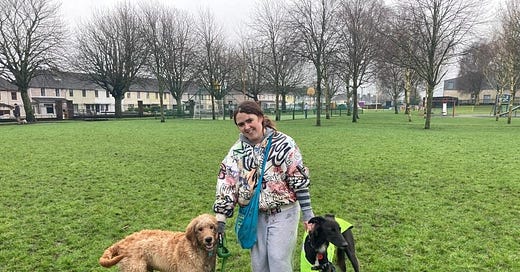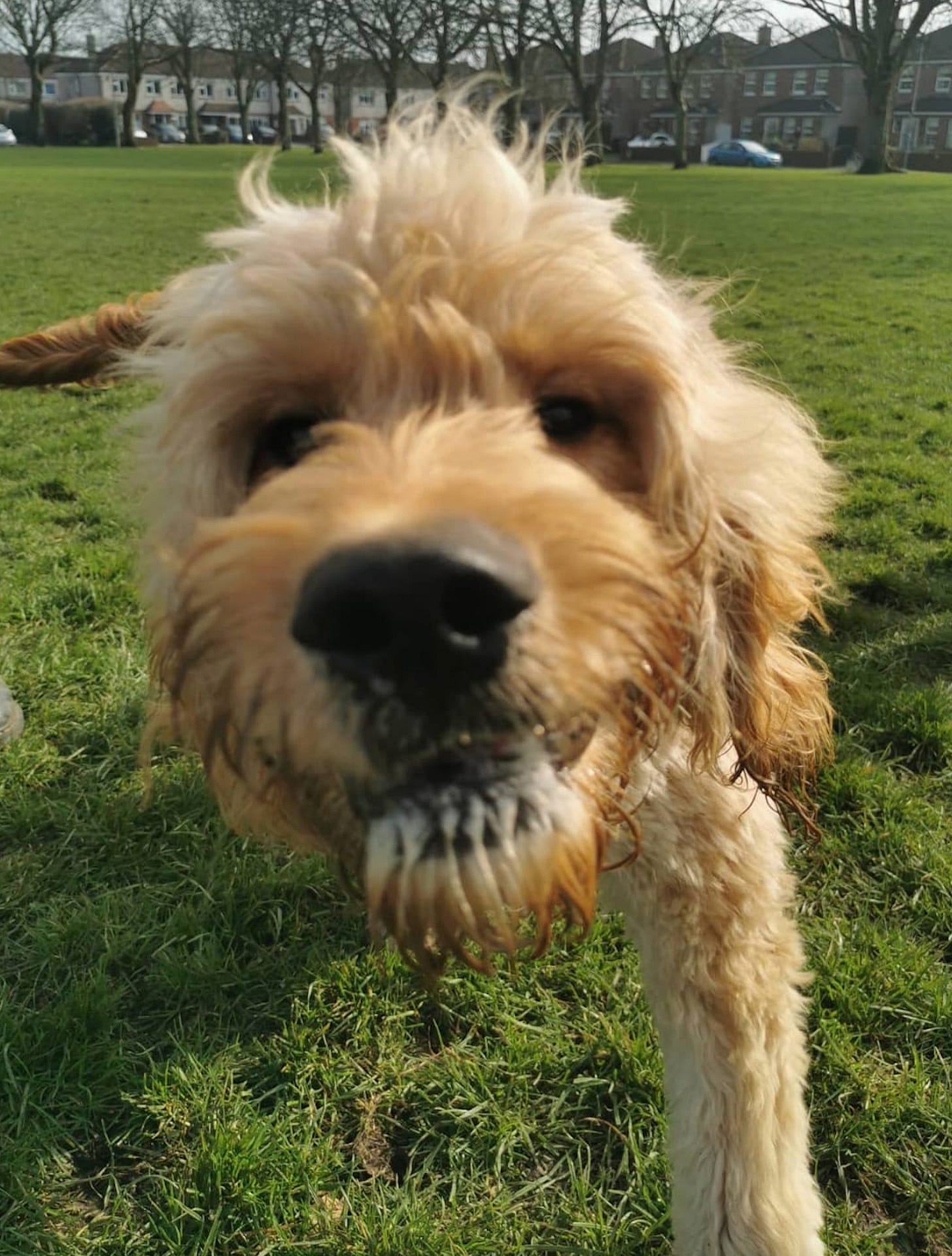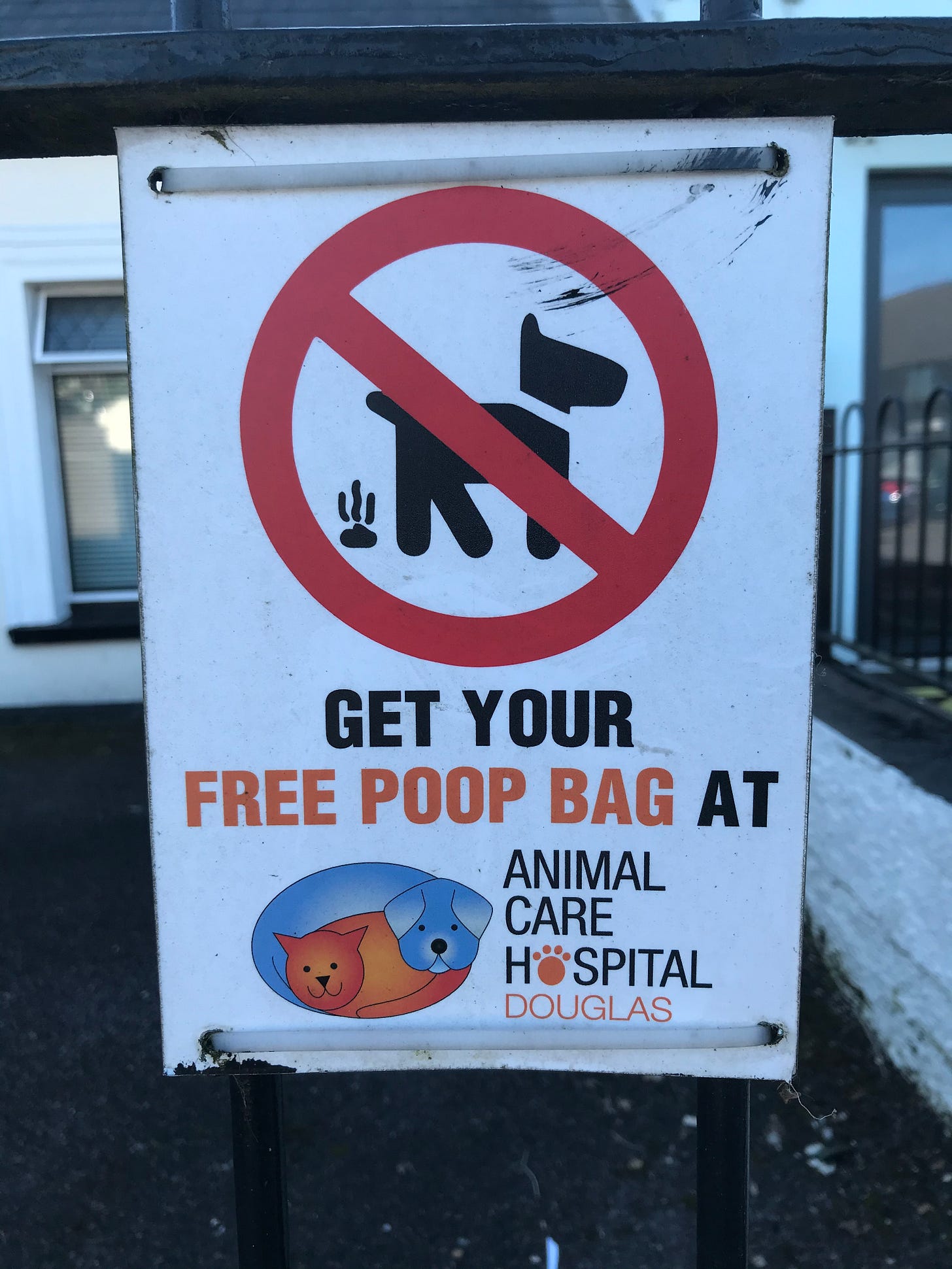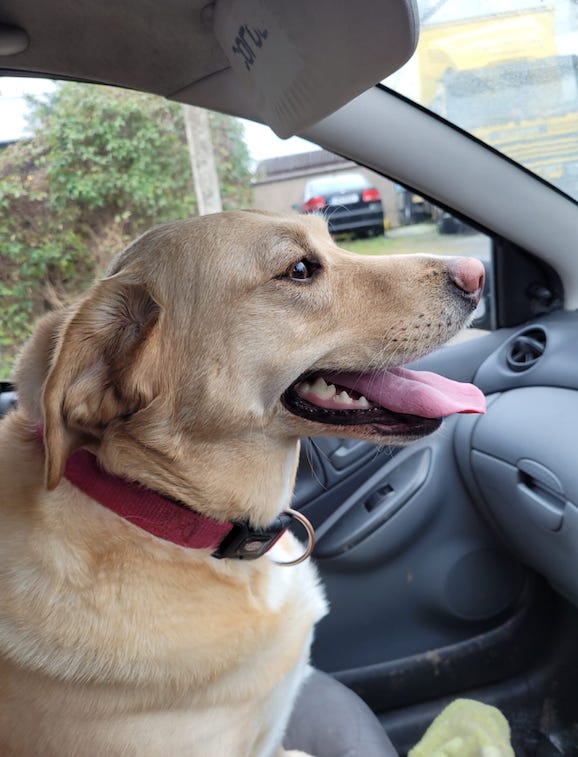The Dog Park Lady
Cork has the biggest dog population in the country, but no dog parks. Mairéad Casey wants to change that.
When you have a newborn or get a puppy, it sets in motion a chain of events which, in hindsight, seems strikingly logical, even intuitive (and exhausting). You need to feed and clothe them, give them toys, pick up after them, change their nappies, scoop up their street deposits.
You go for walks, oh endless walks, oceans of fresh air, and wind your way to the park where there’s other parents and kids, dog owners and dogs.
But it’s here, at the park that the similarities between the pup and garsún come to an end.
For while little boys and little girls run free in the playground, Lucky, well, he or she should be kept firmly on a leash. Not so Lucky, then.
By law, if you have a dog out in public in Ireland, it needs to be on a lead. Dog owners know this. Mairéad Casey certainly does. And it’s also why, inadvertently, she’s found herself in an activist role, spearheading a campaign to get dog parks in Cork city.
For Mairéad, it all started with Lincoln, her two-and-half year old lurcher weighing in at 35 kgs. “He’s pretty tall,” Mairéad says, laughing. “More than one child has described him as a horse.”
Lincoln is Mairéad’s first dog since she moved to the city eight years ago. Originally from close to Macroom, Mairéad now lives in Greenmount, on the south side of the city. Dogs have always been a part of the Casey family.
When Mairéad and her partner wanted to train Lincoln off-lead, they came up against a problem: where do you go that you can walk to in the city that you can leave your dog off its lead?
Nowhere, really.
For a while Mairéad and the band of dog walkers who have, especially in the past 12 months become a community, bound by 5km and united by their range of dogs, let their dogs loose on a pitch up at Tory Top. While that area worked for a while, Mairéad said she always knew the end could come at anytime.
“Even that space was too big for what we needed, but it was great to have a place that we could leave them off and that people didn’t give out about,” she tells me. “Then we got locked out, which made us angry. So we kind of just started this in anger.”
Anger management
That anger found its way to the web - where so much anger flows - but Mairéad channelled it into a petition which she launched on Change.org in early February of 2021. The wording of the petition has changed, from dog park to off-leash park, and the semantic change reflects a more inclusive approach: a park not just for dogs, but where the public will be aware that dogs will be off-leash.
Local media outlets were quick to fall over each other and write up the story, which culminated in a brief spot on 96 FM, which helped boost the petition and garner signatures and supporters. Currently, there’s over 1,600 signatories, giving full support to the idea of off-leash parks, but the media has largely moved on.
The thing is though, as Mairéad points out, calls for a dog park are not new. Mairéad says that looking through the minutes of council meetings, a dog park was being talked about for The Tramore Valley Park as far back as 2014. There was even a separate Facebook group set up in 2015 which garnered over 1,000 signatories. Still though, no dice.
Dog group
When Mairéad got Lincoln he was a rescue dog “and he hated people.” Over time though, he has gained in confidence, especially since the pair started their meet-ups while they had use of the pitch at Tory Top. Central to dog parks is the aspect of socialization, dogs meeting other dogs. (And dog owners meetings other dog owners too.)
“If you want a dog to be a ‘good dog’, it is a part of it, socialising them, letting them play with new friends,” Mairéad tells me.
“A lot of people have got puppies in the last year and they’re like, ‘I’ve nowhere to train them. I can’t train them to come back to me.’ In order to do that, you need to leave them off-lead.”
Mairéad and her group are now using an open space in Deerpark, where a couple of the group are residents. They’re mindful of their dogs, but they’re also aware that the best environment would be an enclosed space. Mairéad says that in her experience, the dogs were a great source of enjoyment for locals.
“When we were on Tory Top, people would stop outside the pitch and watch the dogs because when you see a bunch of dogs play who clearly get along and they have squeaky toys and they’re running and they’re having fun, a lot of people really enjoyed seeing that.”
Onlookers would ask them if they were an official group, but it was all just happenstance. And as you might have noticed, dogs and their owners seem to be everywhere in the past 12 months.
Mairéad thinks that one of the reasons there has been such significant support for her petition for a city dog park is because of how Covid made the world much smaller.
“That’s why we got such support right out the gate,” she says. “Between the amount of people who got dogs last year and the amount of people who suddenly realised that especially when we are in five kilometres there’s not a whole lot you can do with your dog other than take them to the same places and that’s not good for them, or you. They get bored.”
“We just need an area where it’s understood the dog is going be off-leash and you don’t get that look from some people which is ‘Aaah, they’re off-leash again’”.
According to Mairéad there’s judgement, understandably so, from members of the public when they see dogs off-leash: the bigger the dog, the bigger the judgement. Small dogs are likelier to get a pass.
But just because some of the dogs are big, it doesn’t mean they need a big park, despite what the council may feel. Quite the opposite, Mairéad thinks: “They want a giant park, with separation for small dogs and big dogs, with supervision by somebody.”
Big vs small
Stephen Scully, who works with the city council’s parks and recreations team, tells me his department are “looking at the costing up of a feasibility study” to provide a dog park at Ballincollig Regional Park.
Similar to Dublin’s dog parks it would cover an acre of ground - roughly half the size of a soccer pitch - and it would be subdivided for dogs of different sizes.
Stephen says they hope to finish preliminary work in the next couple of weeks, and they’ll have to wait to see what costs are before the council makes its next move.
“You have to do it right,” Stephen says. “You can’t just plonk it in within a park and decide that you’re going to cordon off a particular area. There are costs attached and you’re interfering with other recreational spaces within those parks.”
Ballincollig is a bitter pill for Mairéad and her group. The dog parks they are campaigning for would be sited locally, ideally within walking distance. A park that anchors their community, where the owners know each other, and the dogs are something akin to a family.
“If you have a big central area - what the council are talking about - I’m not going to know those dogs, I’m not going to take him there as often,” Mairead says.
“Even from a financial point of view, local is the way to go, but I can’t get them to see that.”
While Mairead is not at all against the council’s initiative to open a dog park in Ballincollig or Tramore Valley Park, she believes that “on a day to day basis, it doesn’t solve any problems.”
As Mairead points out, most people who leave their dogs off-leash outside of the proposed areas are still likely to leave their dogs off-leash. Which is why they want the council to act local.
“We don’t need anything that big, it just needs to be enclosed.”
The canine capital of Ireland
While reporting this piece I asked Mairéad the same question I put to many others: is a dog park a first-world problem?
“Having a dog park goes a long way to having a well-trained dog,” Mairéad says. She said the training that can be done in a dog park, on recall and on instilling confidence in a dog is “critical”.
On reflection though, perhaps that’s the wrong question.
Dogs are a part of Cork. A big part. In fact, Cork loves dogs. In 2019, between them the county and city council issued 44,105 dog licenses, by far and away the biggest number for any county in the Republic. (In contrast, all four Dublin councils issued just under 32,000 licenses in the same time period). In all likelihood 2020 saw an increase in the dog population; they were the pandemic pet of choice as restrictions forced everyone to stay local.
Yet Cork City Council has been slow on the uptake to make dog parks a part of the infrastructure in the city. Dublin, with nine dog parks, is way ahead of Cork.
Mairead’s group first googled how to get a dog park, and followed the advice of a Canadian woman who gave step-by-step advice on the politics of getting a dog park. They have now contacted every city councillor.
Of the twenty-nine councillors she contacted, everyone responded bar two. In the main the councillors brought up the council’s plans for Tramore Valley Park and Ballincollig Regional Park. But Mairéad counteracts this with the specifics of what she is petitioning for: local parks.
“The budgeting is less for it, it’s more likely to be a success because it’s dogs that know each other and owners that know each other and it gives people accountability,” she says.
Some of the councillors were concerned about dog fighting, but Mairéad believes that yet again a localised approach more makes sense here: the dogs and the dog owners know each other.
Like a lot of other people last year, Shane O’Callaghan says his family thought about getting a dog. In the end the Fine Gael councillor and deputy Lord Mayor didn’t, but he’s fully behind the idea of dog parks and thinks they need to be spread out, including close to the city centre.
Cllr O’Callaghan, who has been in touch with Mairéad, put down a motion for a dog park in Tramore Valley, which falls inside his electoral area, but he tells me he recognises that there “also needs to be a dog park in places that are more central, in addition to other areas such as Tramore Valley Park.”
I ask the same first-world problem question to the deputy Lord Mayor, and while neither he nor any other councillor has to fear losing a dog’s vote, he told me it’s clear that dogs are a part of the city, and thereby dog parks should also be part of the city’s infrastructure.
The “15-minute city”
Mairéad’s focus on local is part of massive realignment of how we are thinking about cities, especially over the past 12 months. That process of re-thinking our cities has moved from staid planning departments into kitchens and playgrounds and in lively online discussions.
Guiding this is the idea of the “15-minute city”. This, from Simon Kuper in The Financial Times, gives you an idea:
The new urban catchphrase — coined by Carlos Moreno of the Sorbonne University in Paris — is “the 15-minute city”, where all of life is close to hand and spaces are used nonstop. For instance, Paris and New York are increasingly opening school playgrounds when school is closed. Many spaces will become adaptable: an office by day, a youth club in the evening.
For the past year Mairéad, a software developer for McAfee, has, like thousands of others across the city and county, worked from home. It’s a change she’s embraced. Nearly every day she gets to take Lincoln out for a walk at lunchtime - he’s poking his head under her laptop if they’re not out the door after midday. She doesn’t need to jump in a car; the group of locals she meets provide support, community, friendship and laughter.
“When you get a dog, instantly you become a member of this club you didn’t realise existed,” Mairéad says. “I’ve talked to more people since I got Lincoln than I ever spoke to in the six years before that I lived in the city.”
Her dog group joke that they wouldn’t know they existed were it not for the dogs, and ultimately they’re trying to make it easier for the members of the public that don’t want or don’t feel easy with dogs running off leash.
“We want those people to enjoy the park. We don’t want conflict with them,” Mairéad says. You’d think the council then would throw dog owners like Mairéad a bone.
While the council is moving in the right direction with its feasibility study for a dog park in Ballincollig, they’re behind the curve on setting their stall on going big, over small and local. The same could be said for playgrounds for children. How many estates come with playgrounds built into the planning process; how many playgrounds are there in the city? And, as has been documented here, the council is not short on vacant or derelict sites. In Mairéad’s dog park petition, she’s received countless suggestions of sites or dog parks. What is needed is imagination and drive.
Or put it another way, imagine there were over 40,000 basketball players spread out across Cork and not a single court.
We need to talk about dog fouling
In Mairéad’s correspondence with councillors, dog fouling inevitably cropped up. Understandably so. Anecdotally, it would seem you can’t go down a road without stepping in dog poo. This annoys Mairéad as much as it does everyone else - bar the small minority of dog owners, who literally don’t give a s**t.
“90% of dog owners clean up after their dogs,” Mairéad says, adding that it’s really frustrating for them as “everyone blames all dog owners for the fact that there is dog poop.”
A recent column by Micheal Moynihan in The Examiner was a bit more understanding, but he couldn’t resist a boomer flourish in the headline: Some dog owners showing utter disregard and making a mess of my city.
While not excusing the bad behaviour of a minority of dog owners, for Mairéad the lack of public bins to deposit bags is an issue. “That’s been brought before council a thousand times.”
According to the council, any public bin can be used to deposit dog waste.
But as Mairéad also points out: what’s so hard about bringing the doggy bag home?
The three dog wardens, as well as the team of litter wardens employed by the city council seem either to not notice or to patrol pristine paths: the last time a dog fouling fine was issued was 2017. While acknowledging there were a few dog owners who didn’t follow the rules, Stephen Scully says there has been no considerable uptick in dog fouling over the past 12 months and that overall, there’s been a vast improvement in this area over the past 10 years.
But, in some cases people have been taking issue with dog fouling into their own hands. Mairéad recounts the story of a resident in her neighbhourhood who, disgruntled with dog fouling outside her house, resorted to pouring bleach on the public footpath. Two dogs were poisoned and had to go to the vet.
Mairéad says it is infuriating to witness other dog owners walk away from a pile of dog fouling. She will call them out, but she also brings spare litter bags.
Cllr O’Callaghan who, as chair of Douglas Tidy Towns, is well used to getting up close and personal to all types of rubbish, shares Mairéad’s sense of fury at having to pick up after litterers and dog owners who don’t clean up.
“It’s a small minority, but they ruin it for everyone else,” he says.
With a local dog park, Mairéad thinks that dog owners from around the area are more likely to support each other, to offer a bag when someone else might not have one, ultimately building up relationships.
When I contact Mairéad a few days after we had first spoken and after talking with city officials, I relay to her something that she already knew: city centre dog parks, or off-leash parks, are unlikely to happen anytime soon.
“To be honest, we were not very hopeful ever since we read the council minutes and saw that Tramore Valley was being proposed since 2014,” Mairéad says in her reply.
But she also knows that doing nothing is more futile, if futility can be measured.
“It's not like we're losing anything by causing a commotion about the need for dog parks,” she says.
Getting Lincoln has taught Mairéad much. Through him, she’s woven her way into a local community of dog-owning friends.
Now she’s learning something else, something bigger, and more complex, and messy: how a city works. Who makes decisions, or doesn’t. Who listens and who responds. Who acts, and who postures.
Mairéad told me her father is making jokes about her becoming a politician.
It’s early days in Mairéad’s petition, but politics has a way of wearing people down. Perhaps though, there’s a lesson for her in the dog with a bone idiom. Plus, every time Lincoln buries his nose under her laptop, pulling at her to get out the door to meet their friends, both canine and human, there’s a reminder of what she’s after.
“It’s about their needs: dogs should have areas to play with dogs in the same way that people would be very judgemental if there was nowhere in this whole city for a child to go play with another child,” she says. “It’s detrimental to their actual development. The exact same with dogs. Anyone who has a dog will tell you it’s kind of like having a toddler except they’re never going to grow up, and that’s the hardest part.”











